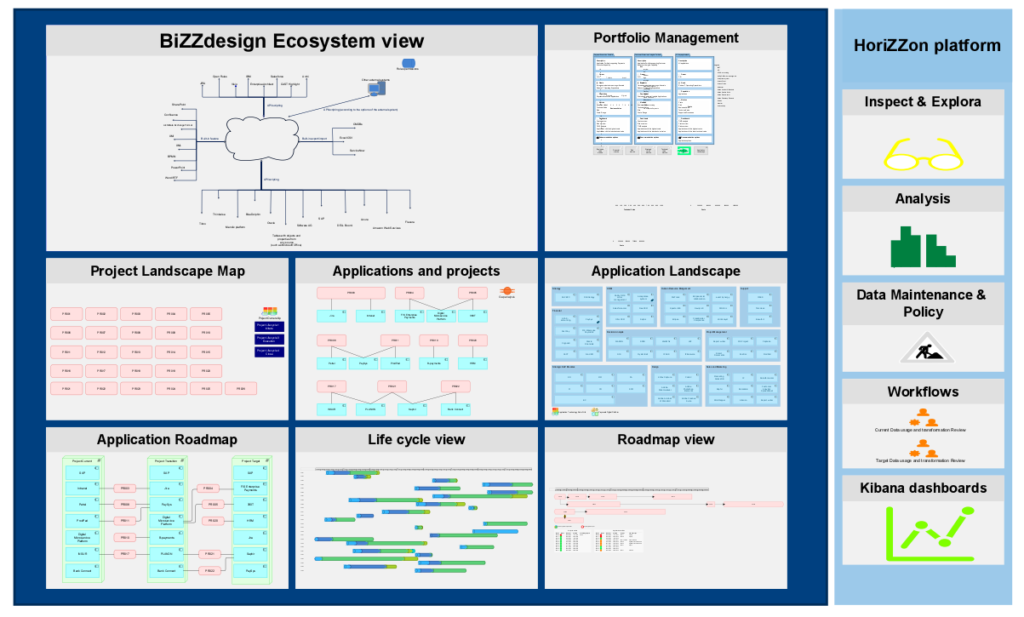
Enterprise Portfolio Management as a basic building block of Enterprise Architecture
Audience: enterprise architect
The previous article described the problem of misinterpretations of Solution and Enterprise Architecture. However, the problems that our prospectuses face do not end here. Particularly recurring challenges include the implementation and realization of an application strategy that streamlines their original portfolio and its current preparation for the influx of a rapid sequence of new business requirements, legislative changes and technologies. The most common problems in this regard include:
- the absence of interconnection between strategy, investment and the current state of applications,
- unclear technological and business value of applications as well as the risk associated with them,
- duplicate and redundant data, or complete absence of data,
- growing technological debt,
- the absence of an overall picture of the organization, ie connections not only between applications.
There are unanswered questions related to these issues, such as:
- Who, how, where, when and why uses individual applications?
- How are applications connected to each other? And how does changing one application affect different parts of the organization?
- Which applications carry the risk of outdated technologies?
- How well do applications support business goals and meet business needs?
- In which applications to invest? Conversely, which applications to maintain and which eliminate?
The above questions are under the auspices of the Enterprise Architectural Department, which must be able to answer them. Holistic Enterprise Architecture (HEA) includes several domains, which, depending on the maturity and level of skills of the Enterprise Architectural Department, deals with. In addition to looking through domains, however, we can look at HEA also through key areas which it deals with. These areas include Risk&Security Management, Business Process Management, Strategy&Business Modeling, Data Management, Portolio Management and others, taking into account HEAs apply different approaches such as Customer Experience Design, Capability Based Planning, or Data-Driven Decision-Making.
In this article, we will take a closer look at Portfolio Management, which, among other areas, approaches and domains, is supported by the robust collaborative platform Bizzdesign. At the same time, the article points out how data scattered in separate systems can be transformed into a form of reliable information that serves as support for decision-making and the achievement of set strategic goals.
The article is created on the example of Application Portolio Management (hereinafter APM) using fictitious data in the Bizzdesign platform environment. Bizzdesign within Portfolio Management does not restrict users to a specific type of entity in the catalogs. On the contrary, it allows you to manage portfolios for various data catalogs, the most common applications, technological infrastructure, processes or capabilities.
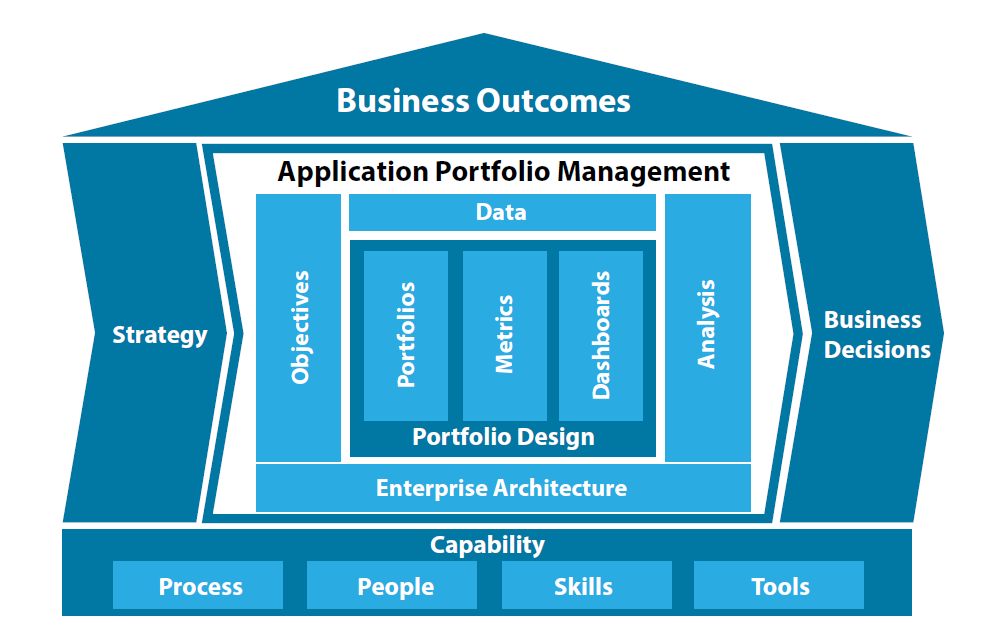
Data Consolidation and Building a Single Source of Truth
The initial action before the initial implementation of Portfolio Management is analysis of data sources and subsequent consolidation of this data. It is necessary centralize relevant data into a single source, while trusting in this data and the sources from which it comes must be ensured. The relevant data are likely to be scattered in different separate systems. Within the APM example, relevant data would be financial data, monitoring data, CMDB data, application lifecycle data, project data, and so on. During data consolidation, it is necessary to ensure the mapping of data to specific applications, to eliminate possible duplications, provided that the credibility of the sources of this data and the data itself has been verified in advance. The problem with the reliability of the data may be due to the fact that it is out of date or, in the case of manually entered data, this data may simply be erroneous. It should not be forgotten that it is necessary to establish a Single Source of Truth through automated integrations that ensure the flow of data at regular intervals. Otherwise, there may be a situation where the data becomes out of date during their processing and preparation for Portfolio Management analysis.
Last but not least, it is our goal obtain data about the connections of individual applications to the surroundings in the organization. However, this step may not be necessary in the case of Portfolio Management. However, from the point of view of HEA, it is necessary to record interconnections and dependencies. This is because even if we identify, within Portfolio Management, for example, loss objects of the managed catalog, there may be a problem in trying to address this situation if there are no interconnections that will allow us to carry out impact analyzes for different scenarios. From the point of view of connecting the application catalog to the environment in the organization, we are primarily interested in the processes in which the applications are used, the infrastructure components on which they are deployed, but also the strategic goals that the organization has set.
The basic goal on which the Bizzdesign platform is being built is to support the creation of a credible Single Source of Truth. The possibilities that this platform offers for integration with external systems have been described in a previous article Solution ≠ Enterprise Architecture. In order to create a Single Source of Truth are available various data import / export options, whether they are built-in connectors, functions supporting standardized interchange formats, scripting language and last but not least Open API (REST). Of course, in this case, there are also extensive customization options for the default metamodel and a platform to support specific organization data. Of the various customization options of the Bizzdesign platform, the most important for the creation of Single Source of Truth are the definition of custom attributes and profiles, customization of objects and Data Blocks (special attributes for which it is possible to set default editors or schedule a value update program), or creating custom workflows.
Example: in the example APM, the Single Source of Truth was built on monitoring, financial, and CMDB data.
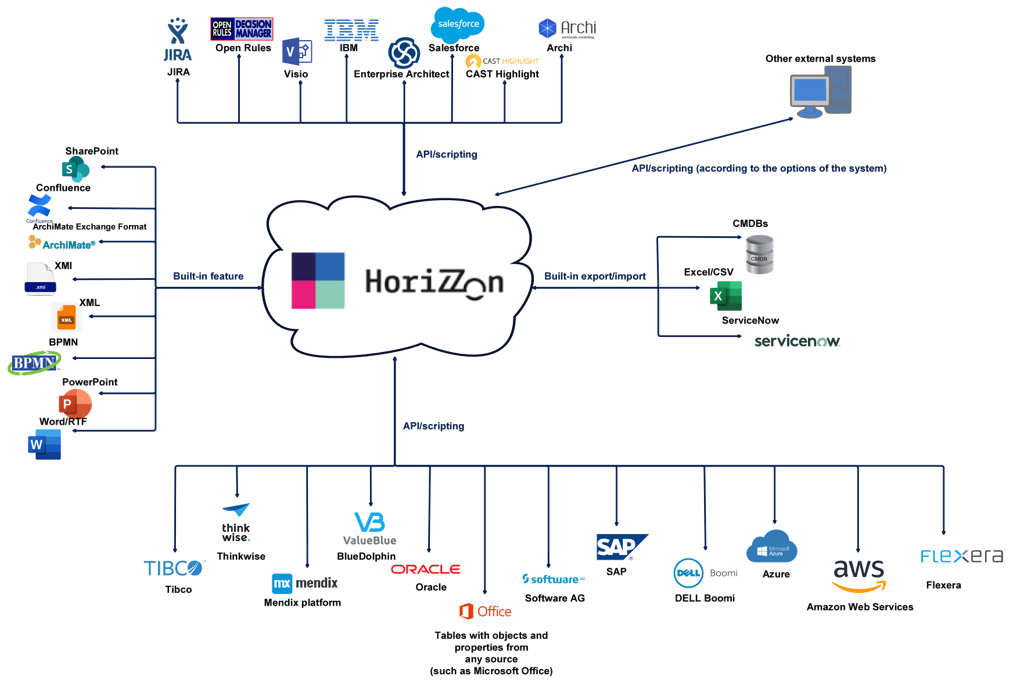
Initial implementation of Portfolio Management
At this point, there is already a Single Source of Truth, over which it is possible to build Portfolio Management. Platform Bizzdesign has a universal Portfolio Management, in which it is possible to manage various data catalogs. The advantage in this case is that Bizzdesign reuses the existing data, ie in the example the application catalog (prevents and at the same time does not create duplicates). At the same time, it is necessary to note that changes in the data flowing into Bizzdesign at regular intervals and form the Single Source of Truth, will automatically be reflected in the Portfolio Management itself.
Portfolio Management in the Bizzdesign platform makes it possible to connect the motivation and strategies of the organization with Portfolio Management itself. Based on these factors, it is then possible to evaluate the current state of the portfolio.
Example: in the sample APM figure as interested CEO, CIO and Portfolio Manager with their goals. Some goals are common, others influence each other. CIO and Portfolio Manager seek to reduce IT costs, thus creating a positive impact of these stakeholders on the goal Decrease IT costs. However CEO with his main goal 5% market share growth negatively affects the goal Decrease IT costs.
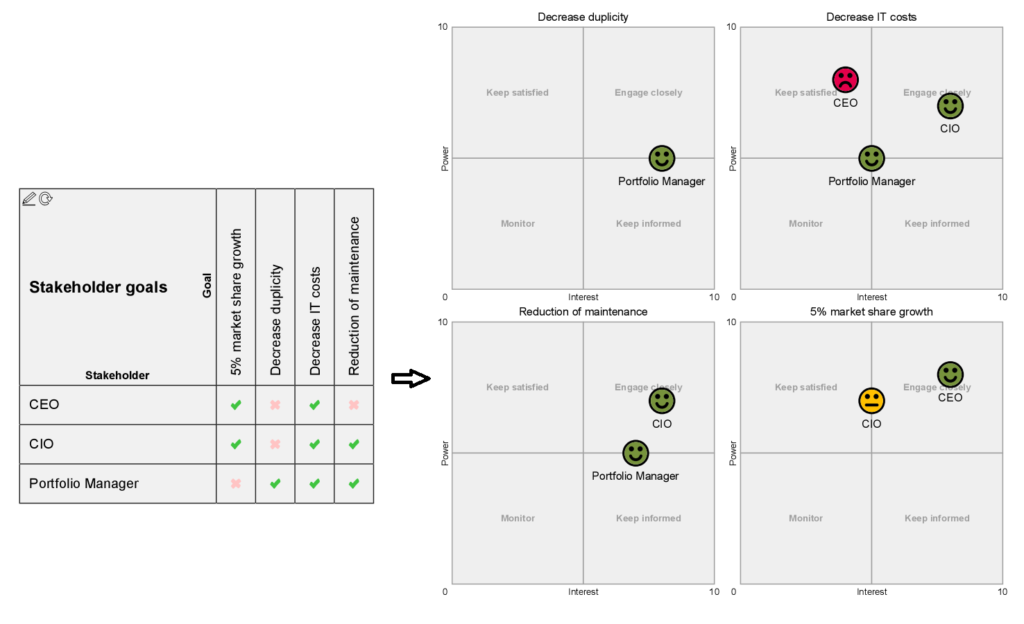
In the following steps , the object catalog is identified which will be managed through the portfolio, specific metrics (holders of values such as price) and understandable charts needed to visualize tracked metrics and attributes. Metrics are defined in the Bizzdesign platform via a graphical interface, while it is possible to create metrics of different data types or aggregated metrics, which are the result of mathematical operation of other metrics with different weights. On the other hand, the charts of the Bizzdesign platform offer the necessary functionality for analysis, such as filtering data based on links, or filtering based on the values of individual metrics and attributes. Last but not least Bizzdesign also allows you to define the so-called Recommendation options. Through these recommendations, it is possible to define actions with related parameters that will be implemented over individual objects of the catalog after its analysis.
Example: in the example APM, aggregated metrics such as IT Fit were created (average of metric IT alignment and IT Risk with the same weight 1.0). At the same time, a recommendation was defined for applications consisting of 4 options Eliminate, Migrate, Invest and Tolarate.

The output of a one-time defined portfolio is an automatically filled dashboardwhich can be analyzed at regular intervals. Below regular intervals is a cycle in which new (changed) data flows from external systems to the Bizzdesign platform. This change will automatically be reflected in the portfolio itself.
Example: several dashboards have been created in the sample APM, including a dashboard via integrated Kibana (an example of Kiban visualization is in the article Solution ≠ Enterprise Architecture). Subsequent analysis of the dashboard, among other things, revealed that the most expensive application in the catalog is the application PaySys. It also has a low business and technical value and is associated with high risk based on an analysis of the outdated technologies on which it is built.
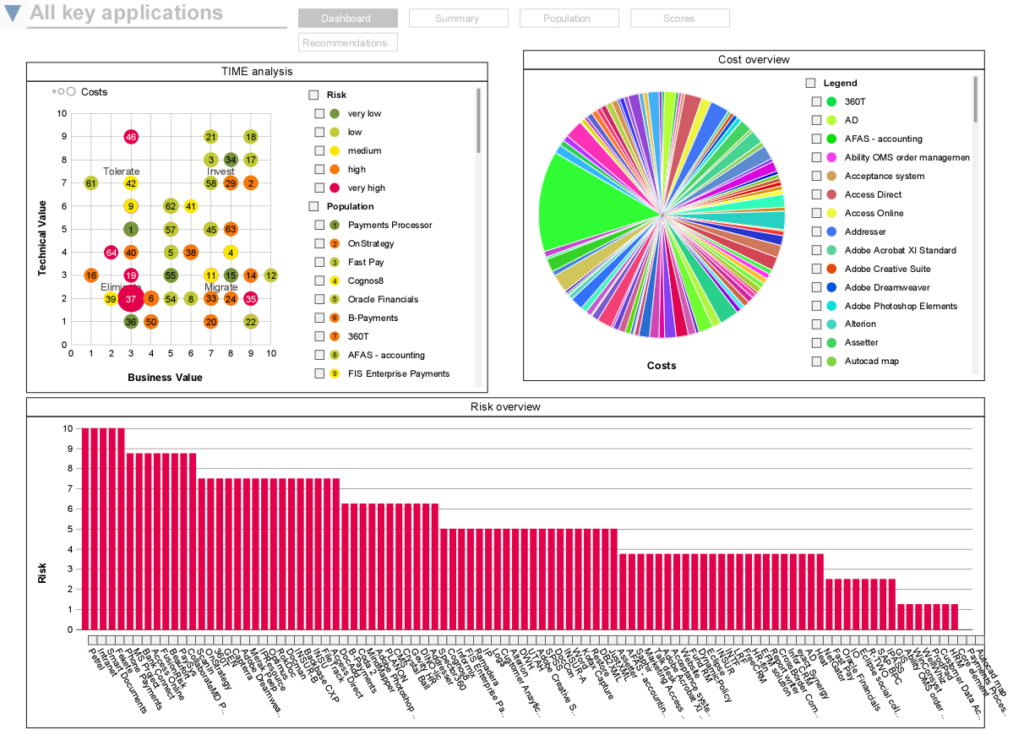
The need to maintain some portfolio status over time is also related to the regular change of data. Examples are the architecture plateaus themselves, the current and target state, but also others. Individual portfolio stocks or so-called snapshots can then be compared with each other. Bizzdesign in this regards provides the functionality to maintain any portfolio status over time. The individual snapshots are then available in a clear timeline, which offers a return to the individual snapshots captured.

Portfolio Management Analysis
At the moment when the portfolio is implemented once, it is possible to proceed to the analysis. This is then performed cyclically at regular intervals. The analysis offers filtering of charts, adding comments and, above all, defining recommendations. The result of the analysis is thus an overview in the form of recommendation tables, which can be an entry point for change design and delivery planning.
Example: recommendations have been defined based on the APM analysis, with some approved, others awaiting revision. This process was provided by its own Workflow, which was defined through the Bizzdesign platform. When defining recommendations (for example, eliminating the application PaySys), the set objectives were also evaluated as Decrease IT costs, which we created at the beginning of the portfolio definition.
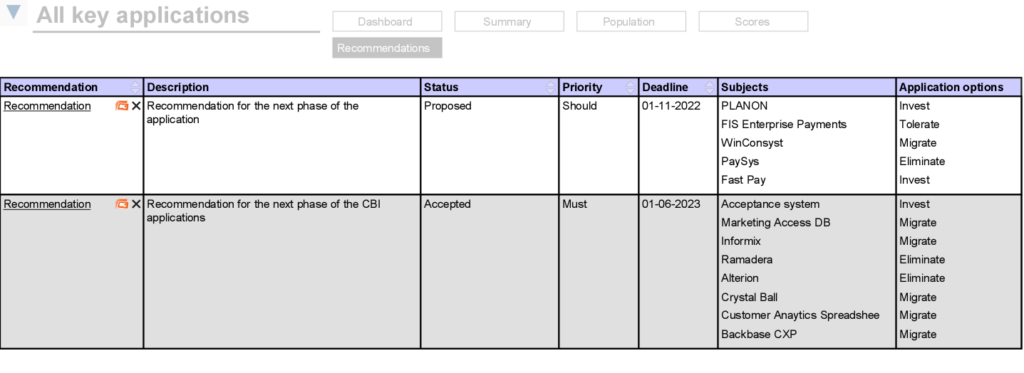
The portfolio analysis itself does not only serve to identify the most expensive or critical objects of the catalog. On the contrary, it also enables responsible maintenance of managed catalog objects in terms of meeting the set strategic goals, KPIs, compliance with standards, internal regulations, or legislation. Closely related to this are other mentioned areas that support the Portfolio Management itself, such as Risk & Security Management, time analysis of data, or categorization of objects and their subsequent evaluation against a set standard, such as GDPR. At the same time, it is sometimes necessary evaluate catalog of objects in terms of specific criteria such as price or risk. For these purposes Bizzdesign has analytics which can be run over various maps (diagrams, views).
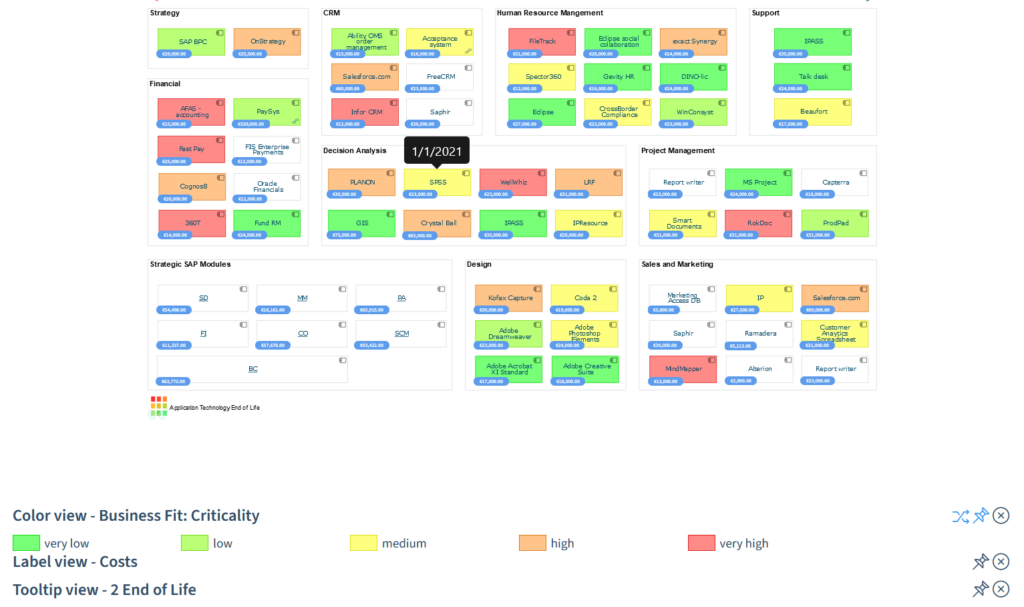
As mentioned in the introduction, from the point of view of Portfolio Management, it may seem that the work is coming to an end. Bizzdesign has enabled us to identify critical components that will be part of the necessary changes. However from the perspective of Enterprise Architecture work is just beginning. Right at this point it is necessary to have a holistic view to the organization and interconnections of individual objects. This will allow impact analyzes to be carried out for the various scenarios of the proposed changes. Subsequently, once the best scenario is identified, it is possible to proceed with delivery planning changes. Bizzdesign supports this effort with specific perspectives such as Roadmaps, or Life cycle views and their automatic evaluation. Automatic evaluation in this direction identifies possible conflicts, for example in the life cycles of the infrastructural components and the application that is deployed on them. However, we will focus on impact analysis and delivery planning in the Bizzdesign platform in one of the future articles.
Example: at this stage, the APM example ends. Its output defined recommendations. In a complete example, they could be taken over by Enterprise Architect, who would suggest several alternative scenarios. He could then compare them using the Scenario analysis view, apply analytics and perform impact analyzes. The best case scenario would then move to the planning stage of its delivery.
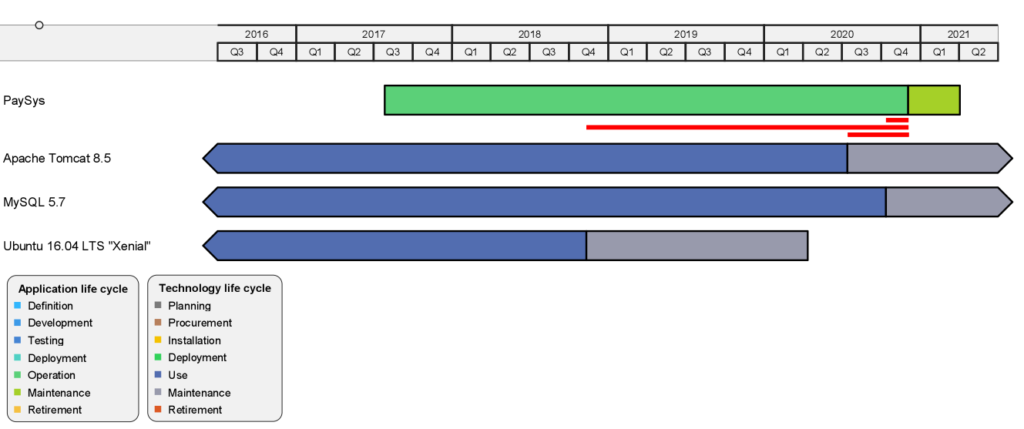
Portfolio Management is a complex issue, which is connected with a number of other areas, such as the aforementioned Risk & Security Management. This is the main strength of the Bizzdesgn platform. Bizzdesign can link individual data and stakeholders, establish a Trustworthy Single Source of Truth and provides management functionality of the mentioned areas at the same time. In an effort to fulfill this vision, Bizzdesign provides users with an ideal combination of functionalities for solving complex problems in the field of Enterprise Architecture.
Example: In an APM example of fictitious data, the original unconnected data maintained in separate systems was transformed into comprehensible and reliable information, based on which recommendations for change were defined. These will lead to the fulfillment of set goals such as reducing IT costs or eliminating duplication.
author Jozef Melicherčík
Sources
[1] Marc Lankhorst, Lianne Bodenstaff, Sven van Dijk, Dick Quartel, Peter Matthijssen, Joost Niehof, 2016 [Date: 01.04.2022] https://go.bizzdesign.com/ebook-Application-Portfolio-Management

